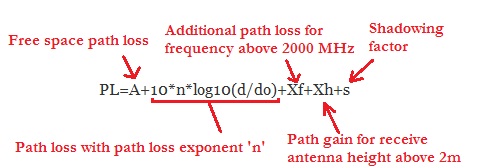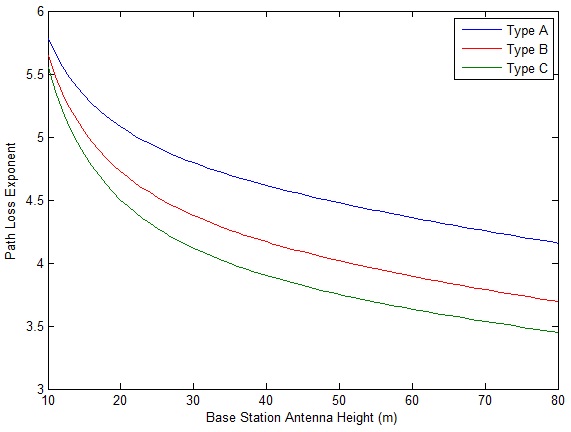As discussed previously the SUI (Stanford University Interim) model can be used to calculate the path loss of a WiMAX link. The SUI model is given as:
It has five components:
1. The free space path loss (A) up to the reference distance of ‘do’.
2. Additional path loss for distance ‘d’ with path loss exponent ‘n’.
3. Additional path loss (Xf) for frequencies above 2000 MHz.
4. Path gain (Xh) for receive antenna heights greater than 2 m.
5. Shadowing factor (s).
The most important factor in this equation is the distance dependent path loss. The impact of this factor is controlled by the path loss exponent ‘n’. It is well known that in free space the path loss exponent has a value of 2. In more realistic channels its value ranges anywhere from 2 to 6. For SUI model the path loss exponent is calculated as:
n=a-(b*hb)+(c./hb)
where a, b and c are SUI model specific parameters. It is obvious that the path loss exponent decreases with increase in base station antenna height ‘hb’. The path loss exponent for various antenna heights is shown below.
It is observed that as the base station antenna height is varied from 10 m to 80 m the path loss exponent for the three scenarios varies from around 5.5-6.0 to 3.5-4.5. Basically what this means is that for higher base station antenna heights the cell radius would be larger. However we need to be careful when making this statement. Higher antenna heights also sometimes results in a weak signal area close to the base station. This is where the antenna downward tilt becomes an important factor. Antenna downward tilt usually has a value around 5-10 degrees. It is somewhat surprising that although it is such an important factor none of the well known empirical models take it into account.
Note: SUI Model was initially formulated based upon the data collected by AT&T Wireless across the United States in 95 existing macrocells at 1.9 GHz.
Author: Yasir
More than 20 years of experience in various organizations in Pakistan, the USA, and Europe. Worked with the Mobile and Portable Radio Group (MPRG) of Virginia Tech and Qualcomm USA and was one of the first researchers to propose Space Time Block Codes for eight transmit antennas. Have publsihed a book “Recipes for Communication and Signal Processing” through Springer Nature.

